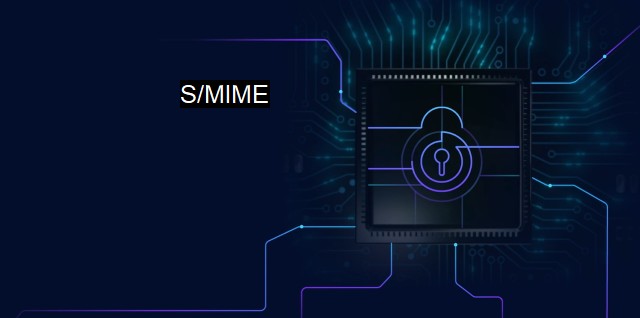What is S/MIME?
The Power of S/MIME: Ensuring Secure and Private Email Communication through Encryption and Digital Signatures
S/MIME, an abbreviation for Secure/Multipurpose Internet Mail Extensions, is a modern protocol that plays a crucial role in the realm of cybersecurity. This globally recognized standard enables robust end-to-end encryption for emails, ensuring secure communication over the internet by protecting the confidentiality and integrity of the transmitted data.The rapidly increasing requirements for privacy and data security drive the adoption of S/MIME. Its application is not limited to emails; it extends to the domains of secure document delivery and e-signatures, contributing to establishing airtight security procedures in corporations, government agencies, and other large organizations.
S/MIME applies the principles of asymmetric cryptography, using a pair of public and private keys for its operation. The sender’s email client uses the recipient’s public key to encrypt the email, ensuring confidentiality by making the data unreadable to anyone without the corresponding private key. The recipient’s email client then uses the private key to decrypt the email. This process ensures that the communication remains confidential as the email can be deciphered only by the proper recipient who is in possession of the matching private key.
S/MIME additionally utilizes a digital signature to verify the sender’s identity and help guard against tampering. The sender’s private key creates this signature, which can be verified by anyone using the appropriate public key. This web of security bolsters trust between the communicating parties and deters potential malicious interception activities.
S/MIME operates based on a system of trusted third-party Certification Authorities (CAs), who issue digital certificates that include the owner's public key and confirm their identity. Only by obtaining these certificates can organizations or individuals utilize S/MIME encryption in their activities. The certificate, installed in the user's email application, ensures the legitimacy and traceability of a message, fending off cyberattacks like phishing and email spoofing where an impostor attempts to impersonate a trusted entity.
Although S/MIME ensures email content confidentiality and authenticity, it does not inherently encrypt metadata like the email subject, sender, recipient, and time stamp, which potentially could be manipulated or used maliciously.
S/MIME is highly relevant in the context of antivirus measures. Incoming and outgoing communications serve as a significant portion of the attack vectors for malware. Data are often transmitted without sufficient protection, making email systems a perfect opening for perpetrators to inject malware or carry out phishing scams. The sturdy protective layer S/MIME offers drastically reduces this vulnerability, blocking potential threats from reaching the network's core. it should be underscoring that S/MIME does not replace a fully-fledged antivirus program but should be used as an additional measure to enhance overall network security.
S/MIME encryption could potentially create conflicts with antivirus programs, as they often need to access email data to analyse and detect potential threats. Solutions such as gateway encryption, which allow encryption and decryption at the organization's security gateway, help overcome this challenge, allowing clean decryption for security inspection and re-encrypting the content afterward.
While S/MIME has proved its worth in secure communication, it also presents limitations such as complexity, cost, and drawbacks involving certificate management. User education and awareness are paramount to ensuring confidentiality and security. Despite these challenges, S/MIME remains the tool of choice for email security and integrity. Implementing a holistic approach, combining S/MIME application with well-rounded antivirus programs helps in establishing a fortified defense against increasingly sophisticated cyber threats.
S/MIME plays a significant role in the cybersecurity landscape, offering robust email protection. It demonstrates the importance of and the need for ensuring confidentiality, integrity, and authenticity of communication in cyber-world, thereby fortifying proactive cybersecurity defense systems. Its broad adoption signals the need for sophisticated tools and techniques to combat escalated cybersecurity threats and vulnerabilities. Despite inherent challenges, S/MIME remains instrumental in establishing advanced and reliable cybersecurity frameworks and in antivirus measures to enrich the resilient infrastructure requirements of the modern digital age.

S/MIME FAQs
What is S/MIME?
S/MIME (Secure/Multipurpose Internet Mail Extensions) is a protocol for secure email messaging that uses public key cryptography to encrypt and digitally sign emails. It is widely used for secure email communication in organizations and businesses.How does S/MIME work?
S/MIME uses public key cryptography to authenticate the identity of the sender and encrypt the content of the email. The sender's email client uses their private key to digitally sign the email, while the recipient's email client uses the sender's public key to verify the signature and decrypt the email.What are the benefits of using S/MIME?
S/MIME provides several benefits for email security, including authentication of sender identity, encryption of email content, and protection against tampering and forgery. It also supports non-repudiation, which means that the sender cannot deny sending the message.Do I need to install any software to use S/MIME?
Yes, you need to install an S/MIME compatible email client such as Microsoft Outlook, Apple Mail, or Mozilla Thunderbird. You also need to obtain a digital certificate from a trusted certificate authority to use S/MIME. Some email clients may have built-in certificate management tools to simplify the process.Related Topics
Email encryption Digital signatures Public Key Infrastructure (PKI) Secure Socket Layer (SSL) Transport Layer Security (TLS)
| | A | | | B | | | C | | | D | | | E | | | F | | | G | | | H | | | I | | | J | | | K | | | L | | | M | |
| | N | | | O | | | P | | | Q | | | R | | | S | | | T | | | U | | | V | | | W | | | X | | | Y | | | Z | |
| | 1 | | | 2 | | | 3 | | | 4 | | | 7 | | | 8 | | |||||||